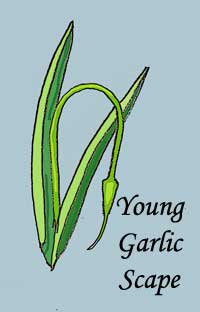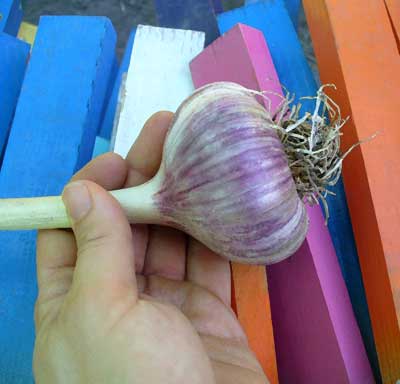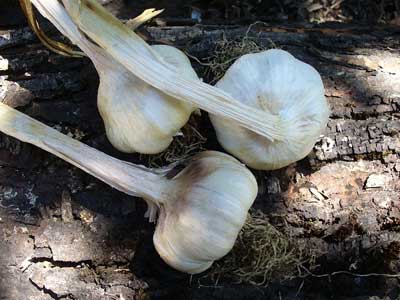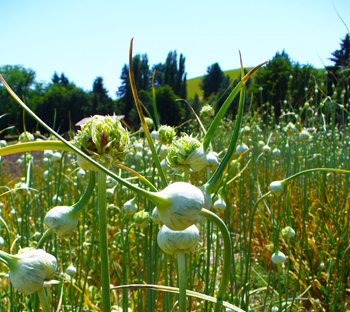Garlic Classification: The Garlic Family Tree Has Tasty Roots
Read About the Ten Garlic Families
Garlic Classification: Hardneck, Softneck and Garlic Origin
 Garlic (Allium sativum L) comes in a wide variety of forms, flavors and colors. There are two subspecies of garlic, the hardnecks, (Allium sativum var. ophioscorodon) and the softnecks, (Allium sativum var. sativum). These two subspecies look and grow differently.
Garlic (Allium sativum L) comes in a wide variety of forms, flavors and colors. There are two subspecies of garlic, the hardnecks, (Allium sativum var. ophioscorodon) and the softnecks, (Allium sativum var. sativum). These two subspecies look and grow differently.
Interesting fact: "Allium sativum'' in the botanical name for garlic, means "pungent cultivated".
Hardneck garlic
Hardneck garlic delights the tongue and is often referred to as gourmet garlic. The flavor range is extremely wide; from hot to mild and from savory to sweet. Normally the bulbs contain a few large uniform cloves in an orderly arrangement.
Hardneck garlic gets its common name from the tall hard woody flower stalk known as a scape which emerges in early summer. This stalk is topped by an umbel or ‘false seedhead’ which encloses small aerial bulbs. The aerial bulbs, known as bulbils, are genetic copies of the parent plant not seeds. The supple scape can develop artistic loops and whorls as it emerges giving it the nickname ‘serpent garlic’. Eventually the long scape straightens out and becomes hard as the bulbils form.
Some people consider the scapes a delicacy and wait eagerly each year for 'scape season'. Most people like the young and tender scapes but a few outliers like the crunchier older scape with mature bulbils.
Picture: Bogatyr hardneck garlic bulb held next to colorful planting stakes. Note the rigid stem or stalk (which is technically the sheathing bases of leaves and the scape).
Softneck garlic
Softneck garlic has a floppier stem, usually has no scape and can be braided. The bulbs are large with a more random distribution of variable sized cloves. It also comes in a cornucopia of flavors. Almost all supermarket garlic is softneck garlic; the most common United States varieties are California Late and California Early. Currently, most of the softneck garlic in the supermarket are imported from China.
Softneck garlic can develop a floppy scape if it is stressed or if it feels like it (we haven't seen a obvious pattern in when our softneck garlic develops a scape). We have a few of our Thermadrones develop scapes each year. Usually these scapes emerge later than hardneck garlic scapes. The bulbils are quite large and tasty. 
Picture: Bold flavored Lorz Italian softneck garlic bulbs resting on bark; note the floppy stalks.
Origin of Garlic
Hardneck garlic originated from wild type garlic, most likely Allium longicuspis, Allium tuncelianum and/or Allium macrochaetum. Although there is some debate of the birthplace of this pungent herb, garlic most likely originated in the mountainous regions of Central Asia (centered in Kyrgyzstan, Tajikistan, Turkmenistan, and Uzbekistan) (Etoh et al. 2001). This climate is hot, acrid, and has low rainfall.
Wild garlic can still be found growing in this region. Originally garlic may have grown wild in a larger area including China, India, Egypt and the Ukraine. The softneck garlic varieties were developed from the hardnecks.
How Garlic is Classified
Garlic classification can be confusing since garlic color, size and taste can be influenced by environmental factors. Garlic seems to be extremely susceptible to epigenetic variation. One of the best ways to determine garlic differences is through genetic testing.
In 2003, garlic genetic testing by Dr. Gail Volk (USDA in Colorado) and Dr. Joachim Keller (Institute of Plant Biology in Gaterslaben, Germany) independently identified ten different ‘families’ or sub-varietal groups of garlic. These ten types are Porcelain, Purple Stripe, Marbled Purple Stripe, Glazed Purple Stripe, Rocambole, Creole, Asiatic, Turban, Artichoke, and Silverskin. Garlic varieties are different in taste, color, shape, number of cloves per bulb, pungency, storage time and growing requirements.
Hardneck families: There are five hardnecks: Porcelain, Purple Stripe, Marbled Purple Stripe, Glazed Purple Stripe, and Rocambole. Hardnecks developed near the Black and Caspian Seas.
 Picture: Mature hardneck garlic forms a false 'seedhead' filled with small bulblets.
Picture: Mature hardneck garlic forms a false 'seedhead' filled with small bulblets.
Weakly bolting hardneck families: There are three weakly bolting hardnecks: Creole, Asiatic, and Turban. Asiatic and Turbans developed in the East. Creoles developed in Spain and southern France and grow extremely well in the extreme South.
Softneck families: There are two softnecks: Artichoke and Silverskin. These developed in Italy and Europe. Softnecks are very prolific and grow well in the North and South United States.
For more on these garlic varieties see Garlic Families.
References:
Etoh T, Watanabe H, Iwai S. RAPD variation of garlic clones in the center of origin and the westernmost area of distribution. Mem. Fac. Agric. Kogoshima Univ. 2001;37:21-27. AGRIS.
